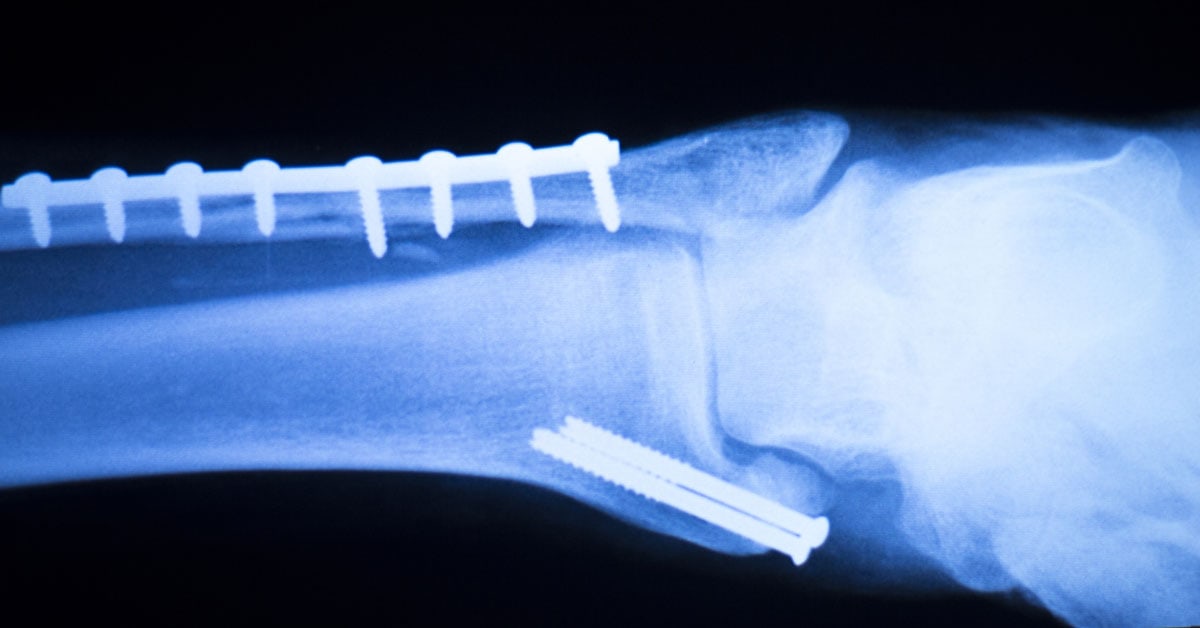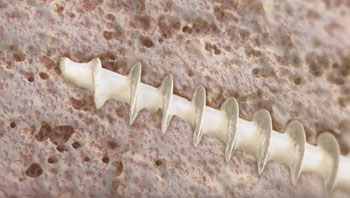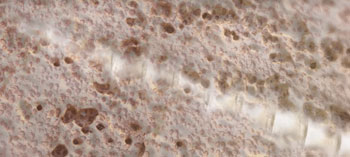
Surgical correction of foot problems, like hammertoes and bunions, often requires using internal fixation devices like screws, pins, wires, rods, and rigid plates. Until recently, this hardware was made of metal alloys or stainless steel.
In recent years, however, titanium became most surgeons’ metal of choice due to its high strength, versatility, and ability to resist corrosion.
Side effects from having titanium in the human body?
Long term presence of titanium, or any metal in the body, can sometimes lead to problems. Because of this, surgical fixation devices may eventually need to be removed. That said, in most cases having a titanium implant does not present an issue.
But the bigger issue with most internal fixation devices is that they are a permanent solution to a temporary problem. That’s because they are often only needed to provide support to a surgically corrected fracture until the bone has had enough time to fully heal. Eventually, there comes a time when the fixation device is no longer needed.
Some of the side effects of having metal in the body include:
- Corrosion: Titanium is relatively corrosion resistant. However, given enough time within the human body, even titanium may eventually corrode and require removal.
- Leaching: Ions from the titanium can leach away from the surgical site to nearby tissues. Metallic deposits from surgical fixation devices have been found in lymph nodes located near the surgical site.
- Growth Retardation: There are indications that the restrictive nature of metallic implants impedes bone growth and so implants placed in growing bone have to come out sooner than later.
- Hardware Loosening: Metal implants can sometimes come loose from the bone and drift. Over time, this can lead to inflammatory reactions, protrusion of the implant through the skin, and painful hypersensitivity to cold temperatures.
Due to all of the above reasons, surgical removal of a metallic device may sometimes be necessary. Surgical hardware removal can be expensive, time-consuming, complicated, and painful.
A state-of-the-art change for fixation devices has arrived at UFAI
A small Massachusetts and an Israeli company named Ossio was recently granted FDA 510(k) approval for its family of bio-integrative orthopedic fixation devices. “What this means is that metal fixation might start becoming a thing of the past.”

I’m enthusiastic about Ossio’s breakthrough technology. In Orthopedics This Week I was quoted as saying: “Ossio has a revolutionary new platform that will change the way we think about orthopedic fixation for both bone and soft tissue.”
Ossio’s products provide an “unprecedented combination of mechanical strength and natural bone healing in a non-permanent implant.”
“Non-permanent” is the most intriguing part of that description. The very nature of metal makes metallic surgical appliances pretty much permanent, at least in relation to a human lifespan.
How does Ossio’s new technology work?
Ossio has come up with an innovative matrix design called OSSIOfiber. It uses thousands of fibers made from minerals naturally found in bone. Ossio binds these fibers together with a permeable polymer (adhesive material).
OSSIOfiber is initially stronger than the bone it temporarily replaces
It provides steadfast early stability, followed later by complete bio-integration as the implant is resorbed by the body.
This gives surgeons a more biologically friendly way to restore bone stability and mobility while leaving nothing artificial permanently at the surgical site.
What is bone resorption?

Here’s where the word “resorb” becomes important. This verb has languished near the bottom of English language popularity polls since 1640, but it’s recently gained new medical significance.
Resorb is generally defined as: “to break down and assimilate the components of (as bone).” Merriam-Webster illustrates the medical meaning of resorb as: “New bone is continually formed and existing bone is continually resorbed throughout life.”
In other words, your skeleton is constantly reforming itself, through the process known as resorption, throughout your lifetime.
And this is where this new FDA approved technology comes into play.
Natural bone resorption slowly but surely infiltrates Ossio’s bio-integrative surgical fixation material
Ultimately, all the implant material is incorporated into the newly healed bone structure. Just as it does with its own natural bone, the body will eventually break down and assimilate (i.e., resorb) the components of OSSIOfiber™.
Why choose University Foot and Ankle Institute for state-of-the-art foot and ankle care
If you’re experiencing foot problems, we’re here to help. Our nationally recognized foot and ankle specialists offer the most advanced podiatric care and the highest success rates in the nation. We are leaders in the research and treatment of all foot and ankle conditions.
For more information or to schedule a consultation, please call (877) 736-6001 or visit us at www.footankleinstitute.com.
We are conveniently located through the Los Angeles area with locations in or near Santa Monica (on Wilshire Blvd.), Beverly Hills, West Los Angeles, Manhattan Beach, Northridge, Downtown Los Angeles, Westlake Village, Granada Hills, and Valencia, California.
- Do Blood Pressure Medicines Cause Foot Pain? - July 22, 2024
- What Is Erythromelalgia? - June 4, 2024
- Struggling with Toe Cramping and Curling? Here’s What To Do! - May 5, 2023
Leave a Reply